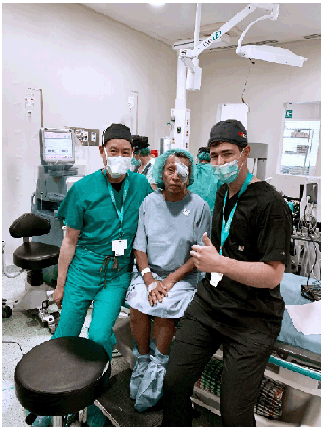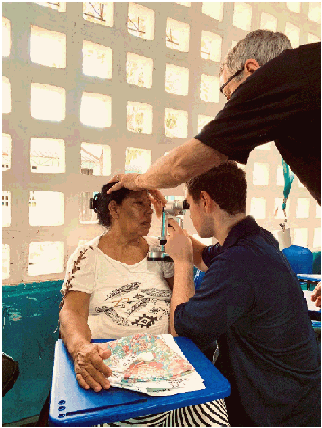With a patient after a successful cataract surgery in Montemorelos, Mexico.

Ethan Waisberg1
doi: http://dx.doi.org/10.5195/ijms.2022.1152
Volume 10, Number 1: 86-88
Received 06 08 2021: Rev-request 29 08 2021: Rev-request 11 10 2021: Rev-recd 29 08 2021: Rev-recd 27 10 2021: Accepted 29 11 2021
Before choosing a specialty, medical students should obtain clinical exposure to that area. However, how can a medical student do that when clinical placements are years away, at the end of medical education? I asked some specialists if I could shadow them during the summer, but they were too busy to do so. Moreover, the clinics and hospitals in my community that I contacted were unable to accommodate me as their observerships were restricted to upper year students or residents from specific universities. Through internet searches, I discovered that I could volunteer on medical mission trips to underserved countries, where I could gain early clinical exposure.1,2 Since you must pay for your own trip and airfare, such missions can be very expensive depending on the organization. Therefore, it is important to do your own research to make an informed decision, as prices, length of stay, specialties involved, surgeries, and number of participants will vary. Some organizations offer fundraising options or tax receipts to help offset the cost. Moreover, it is prudent to research an organization's legitimacy, reputation, and long-term presence with the underserved population. Do they offer programs with lasting benefits, licensed physicians as part of the group, and preferably a charitable or not-for-profit organization? Ask people who have completed these medical mission trips about their experiences and what to expect.
Wanting to explore ophthalmology as a possible specialty, I chose an ophthalmic mission to an underserved community in Montemorelos, Mexico, run by a charitable organization called Medical Ministry International (Figure 1). As a Canadian citizen, I chose a mission run by a reputable Canadian charity because it fit my schedule, was just one week long in case I did not like it, was reasonably priced, and it involved a small group of ophthalmologists, most of whom had attended that trip annually for the past 10 years, proving their satisfaction. I went on this mission in the summer after my second year of medical school (a six year direct-entry program in Ireland), prior to having any formal clinical experience. The mission took place in Montemorelos, a small city in northern Mexico's orange-growing region. Our mission took place at Hospital la Carlota at the University of Montemorelos. Missions sometimes involve travel to unsafe places so make sure you check government travel advisories and search the organization's safety record and whether they offer evacuation and health insurance. Safety was not an issue for me. Each day brought new adventures and learning opportunities. About 100 patients were brought to the hospital daily from rural villages for cataract surgery, and the mission group often operated for ten or more hours in a day. My role was to help manage patients and observe surgeries. I was fortunate to rotate among the operating rooms to observe the various surgical styles and learn from different ophthalmologists.
Figure 1.With a patient after a successful cataract surgery in Montemorelos, Mexico.

The doctors kindly explained things and offered to mentor me. Since none of what I observed had been taught yet at medical school, this early clinical exposure was very helpful in deciding whether this specialty suited me. Though I was not previously thinking of becoming a surgeon, this trip helped me decide that it was what I wanted. I was impressed by the life-changing impact of surgery on patients and their families.
Critics claim that medical missions are only short-term and do not develop sustainable local partnerships.3 However, teams on this mission developed sustained long-term local presence by teaching local residents, doctors, and nurses at the hospital new techniques to improve surgical outcomes. They also remained available by email or telephone after leaving, should the local medical team require their advice. Most doctors on that mission have returned, some as many as ten times. One doctor has donated all the medical equipment from his multiple surgical clinics upon retirement, providing that mission hospital with state-of-the-art equipment it could not otherwise afford.
Other criticisms of medical missions are that students are under-supervised or are required to do clinical duties that are not appropriate in their own nations, or that patients get substandard care.3 On this mission trip, I received and witnessed proper supervision, saw patients treated with respect and given high quality care. Others criticize missions as “voluntourism”4 but in my experience, our team helped improve the health of the local population and gained important service learning. Each doctor I spoke to on the mission believed that physicians have an obligation to the medically underserved in developing countries. Critics complain that medical students should volunteer in underserved populations at home instead,5 but I could find no comparable opportunity in my community for early exposure to a specialty.
This experience being so enlightening, seven months later I joined another medical mission (with the same organization, but different volunteers) in Ciénaga de Oro, Colombia (Figure 2). It had many more volunteers, lasted two weeks, and featured different surgeries and clinical examinations. It even provided me an opportunity to write a research article which was recently published in a peer-reviewed medical journal.6
Figure 2.Assisting with eye exams in Ciénaga de Oro, Colombia.

Reflecting on these experiences, medical mission trips gave me invaluable insight into a specialty, early clinical exposure, new contacts, mentors, networking opportunities, new cultural experiences in other countries, a new language, involvement in research and article writing, and opportunities to serve the underserved. These experiences helped me make a better-informed decision on pursuing a specialty, expanded my global outlook, and kindled a desire to pursue global health in an international elective, residency, or fellowship. I began to feel the puzzle pieces of my medical student education beginning to fall into place.
Missions can greatly benefit medical students in addition to those in need. Participation is likely to benefit one's future career, making one better prepared to be a doctor. Once medical missions fully resume after COVID-19 travel restrictions are lifted, I hope to participate in many more. I highly recommend medical students participate in at least one medical mission to see for themselves. For me, this was definitely an ‘eye-opening' experience!
None.
The Authors have no funding, financial relationships or conflicts of interest to disclose.
Writing – Original Draft, Writing – Review & Editing: EW.
1. Soboka JG, Salamanca O, Calise A. My Experience with Orbis International and the Flying Eye Hospital in Ethiopia. Int J Med Stud.2021;9(1):68-70.
2. Bonilla-Escobar FJ. Fighting blindness with a Guerrilla: The Guerrilla Eye Service of Pittsburgh. Int J Med Stud. 2017;5(3):117-120.
3. Sullivan HR. Voluntourism. AMA J Ethics. 2019 Sep 1;21(9):E815-822.
4. Snyder J, Dharamsi S, Crooks VA. Fly-By medical care: Conceptualizing the global and local social responsibilities of medical tourists and physician voluntourists. Global Health. 2011 Apr 6;7:6.
5. Stoltenberg M, Rumas N, Parsi K. Global health and service learning: lessons learned at US medical schools. Med Educ Online. 2012;17.
6. Waisberg E, Harvey J. Methods and findings on an ophthalmic mission trip to Colombia. Pan Am J Ophthalmol. 2020;2:33.
Ethan Waisberg, 1 MB BCh BAO student, UCD School of Medicine, University College Dublin, Belfield, Dublin 4, Ireland
About the Author: Ethan Waisberg is currently a fifth-year medical student of University College Dublin, Ireland of a 6-year MB BCh BAO program. He is the recipient of the University College Dublin Alfred Myles Smith Award, Finalist of the Ireland Student Medical Summit and the UCD Advantage Award.
Correspondence: Ethan Waisberg. Address: Health Sciences Centre, Belfield, Dublin, Ireland. Email: ethanwaisberg@gmail.com
Editor: Francisco J. Bonilla-Escobar. Student Editors: Mohamed Fahmy Doheim, Michael Tavolieri. Proofreader: Ciara Egan. Layout Editor: Lina Hemmeda. Process: Peer-reviewed.
Cite as: Waisberg, E. Eye-Opening Medical Missions. Int J Med Stud. 2022 Jan-Mar;10(1):86-88.
Copyright © 2022 Ethan Waisberg
This work is licensed under a Creative Commons Attribution 4.0 International License.
International Journal of Medical Students, VOLUME 10, NUMBER 1, Jan-Mar 2021